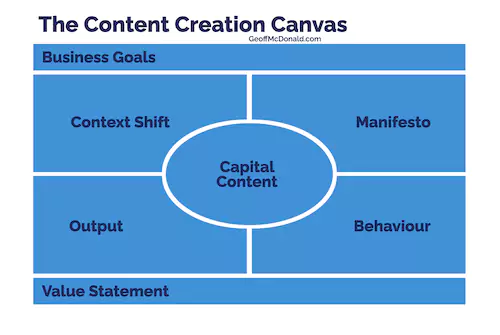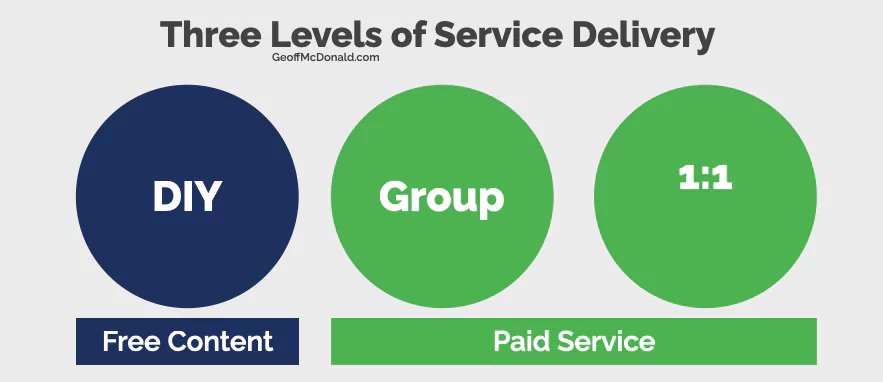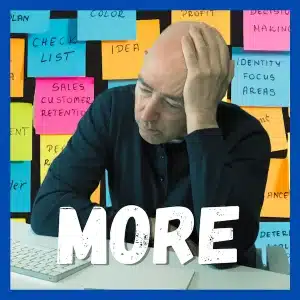What’s the best thought leadership content strategy?
How do you turn your thought leadership IP into content marketing that attracts new clients AND keeps existing clients?
Why you should stop trying to multi-task your Content
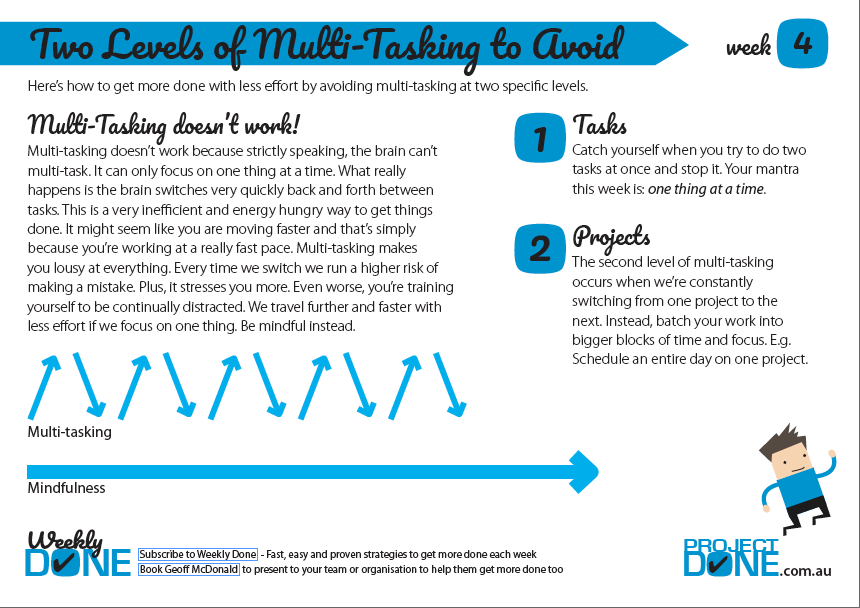 Neuroscience shows that our human brains can only focus on one thing at a time. We can’t multi-task.
Neuroscience shows that our human brains can only focus on one thing at a time. We can’t multi-task.
When we think we’re multi-tasking our brain is flicking back and forth between two tasks.
Back and forth, back and forth, back and forth.
It’s stressful, tiring and not very effective, isn’t it?
But this is how many thought leaders, content creators and professional service firms approach their content marketing. They produce one set of content to attract new clients. Then they produce another set of content to keep their existing clients happy.
Back and forth, back and forth, back and forth.
The other strategy many adopt is worse – they only produce content to attract new clients. The problem with this strategy is that it is 5-25 times cheaper to keep your existing clients than attract new ones.
Capital Content: One set of content to attract and keep clients
 In this post, I’ll show how to avoid both of these situations.
In this post, I’ll show how to avoid both of these situations.
I’ll show you how to produce one set of content that attracts both new clients and keeps existing clients.
Best of all, there are only three key questions you need to answer.
That’s why this is the best Thought Leadership Content Strategy. It’s a single strategy that serves two purposes.
It’s like watering two sets of plants with one hose.
The Content Creation Canvas Series
In our previous two posts, we talked about creating thought leadership solutions for your clients’ problems – creating your Context Shift (Part 3) and Manifesto (Part 4).
Today we want to turn your IP creation into your Content Marketing so you can attract new clients and keep your existing clients.
It’s all about creating Capital Content it’s part 5 of our series on the Content Creation Canvas.
And it’s the best Thought Leadership Content Strategy in three questions. It has three parts:
- Keep your Existing Clients
- Attract New Clients
- The Overlap between the two
How to keep your existing clients longer
When you mention Content Marketing, most people immediately think about attracting new clients. But this is a big mistake.
In 2014, Amy Gallo had an article published in the Harvard Business Review. She reported that it is five to 25 times more expensive to attract a new customer than service an existing one.
This means it’s better to focus on serving your existing clients to keep them than to be constantly chasing new clients.
We spoke about this in the post, The Five to 25 times better Content Marketing Strategy.
Question One: To grow your business obsess over this
Therefore, your first question needs to be based on how to keep your existing clients.
And it’s a question that you should focus on every single day of being in business:
How do you provide value to your clients?
The Usual Response

They say something like…
- I’m a keynote speaker, I do presentations.
- As an author, I write.
- I’m a consultant, I help people.
That’s like saying Gordon Ramsey cooks. Yes, of course, he does. He is one of the world’s best chefs.
But what we really want to know is HOW. What makes Gordon Ramsey a great chef? HOW does he do it?
The more specific you can be about how you provide value to your clients the better your marketing results will be.
A Great Response
One of my clients is a facilitator. When I asked her how she did this, she said, “I create space for conversations”.
Wow. Now you’ve caught my attention. That’s such a beautiful answer. And instantly, I’m interested, engaged and curious about how you do that. How do you create space for conversations?
That’s what we need here. This gives us something powerful to work with.
A Marketing Lessons from Kaizen, Lean and Six Sigma
Have you heard of Kaizen? Lean manufacturing? Six Sigma?
All these movements derive from the Toyota Production System. They are seen as leaders in how to manufacture high-quality products.
One of the tools they used is called The Five Whys.
Essentially, when something goes wrong, you stop to investigate by asking the question: Why did this happen?
And you do it five times. It sounds like a four-year-old child, doesn’t it?
The Five Hows
The key to the Five Whys process is to ask the same question to deepen your understanding of the problem.
We want to use the same process but instead ask, ‘How’. You want to dig deep into how you produce value for your clients.
The Five Hows in Action
Here’s my personal example of The Five Hows.
The first question you need to ask is: what do you do? I help business experts earn money from what they know.
Then we want to ask the how question five times.
- How do you do that? Through creating IP and content
- How do you do that? Through designing models and frameworks
- How do you do that? By identifying core principles
- How do you do that? By talking about how they help their clients
- How do you do that? Through asking the question: If a client was in front of you now with this problem, what would you suggest they do?
Can you see how specific this is now?
Can you also see the things I can create content around?
- How to design models and frameworks
- What’s the best way to define your core principles?
- How to talk with your clients
it’s your turn… How do you provide value to your clients? Ask the how question 3-5 times to be specific about this.
Question Two: How to Attract New Clients
Now for the second question in our best Thought Leadership Content Strategy.
It’s where most people want to focus – how to attract new clients.
The Impossible Challenge of Selling Yourself
The big problem here is that we need to try to understand what it’s like for new clients to buy from us.
But that’s impossible for two big reasons.
- Firstly, you can never see yourself as clearly as others see you.
- Secondly, you cannot see yourself for the first time. You know too much about yourself – including all your foibles.
And this is where your marketing and selling go wrong. You talk about how you see the world and not how your potential clients see it.
We talked more about this in the post: Create your Killer Client Value Statement in Three Steps
What do you do to overcome this?
- You could employ a coach to help you.
- You could do some market research to find out what people think.
- Or you could simply ask this question:
Where have you bought something similar?
From this answer, we can find some general principles you can adopt that you can use in your content marketing.
Let’s look at an example.
Example: Where have you bought something similar?
There are three steps here.
- First, think about the service you provide. Don’t be too specific here. For me, it’s as broad as online group coaching.
- Second, who provides a similar service that you have bought from recently? For me, I bought a monthly subscription to a service to help me create grow my business through video. Clearly, I bought this service because I’m not an expert in this area but the way they deliver their service is like my business.
- Third, write down the things that you wanted to be addressed before you made your purchase.
Six things to address in your marketing materials

- Easy – It looks simple and relatively easy to get results.
- Trust – I want to know, like and trust the person I’m going to be working with.
- Generous – They appear to be generous with their thoughts and show they want to help.
- Social proof – evidence of other people who have been in my situation and have succeeded.
- It makes sense – there is some logic or rationale to their process.
- Consistency – someone who shows up and has a track record of being in that area of service.
You might have some other items to add to this list and this is a good start.
The Forgotten Part of Content Marketing
Now you want to find ways to address these issues in the content that you produce.
There are two parts to this.
The first is your website. You need to address these issues on your website so when a potential client visits, they have their purchasing questions answered.
Too many people – including me – put all of their attention on creating Content Marketing but fail to generate any leads because their website sucks.
What’s the point of publishing content?
It’s to have people visit your website and opt-in to your newsletter.
From this base, you might make a sale.
But why would you spend all of this time, effort and energy creating great content but not have a great website?
Remember, your website is an important part of your content marketing.
The Big Mistake People make on their Dating Profiles

The second is to show this in your content marketing.
Notice the word, ‘show’. It’s show, not tell.
One of the big mistakes many people make when writing a profile for a dating site is that they say, ‘I have a good sense of humour’. While that’s a desirable quality if you only say that we’re not likely to believe you.
But if you demonstrate that by saying or showing something amusing, then we’re more likely to believe that.
Why you should use video on your website
Also, how you show things is crucial.
If you want people to know, like and trust you, then it’s hard to do that if you only write words.
How many times have you read an email and misinterpreted what’s being said?
That’s because our words don’t always fully express our emotions.
Hearing your voice on a podcast will always build a better connection than just words on a page because we can hear the emotion in your voice – and we can hear you laugh also.
Naturally, video is better than words and audio because we can see and hear you.
That’s not to say you should only produce video, but in today’s world, having some video on your website and content marketing is vital.
Question Three: Create the Overlap
Now that you’ve looked at the world through what your existing clients want and what your new clients want, you can start to look for the common threads.
You want to do it in a particular way.
My Pet Hate in Business
One of my pet hates in business is that many people treat their existing clients differently to potential clients. For instance, potential clients are offered a discount when existing clients don’t get the same offer.
That sends a bad message. It suggests that your loyalty and your relationship as an existing client is not as important as that of someone you don’t even know.
That’s like being friendly to a stranger while being mean to your partner. That’s not going to work!
The key principle for content creation
The principle I suggest you consider is this: Treat everyone as if they are a client.
Firstly, that’s a good thing because that’s what good human beings do – they treat everyone the same.
Second, it’s good for business – you never know which existing clients will become your best client – or even your friend. And you never know which new clients will become your best client – or even your friend.
This brings us to our third question in our best Thought Leadership Content Strategy.
Rather than thinking about whether someone is a paying client or not, I suggest you think about everyone as a client.
Some clients pay you money, some clients don’t. Or at least not yet.
That doesn’t mean you have to answer every phone call from everyone who calls you wanting advice. But it is a great perspective from which to create your content.
To do this, answer this question:
How do you support your clients when you’re not there?
This sends an important signal: I can’t be there right now, and I still want to help. Most importantly, it says: I care.
The Austin Powers Rule for producing Great Content

The question is the same but the way we answer will have to change.
For a keynote speaker, when you are in the room with a live audience you can create an awesome experience for them. When you’re not there, you can still engage, entertain and inform them. But you’ll have to do it differently. For example, when on stage, you can use the space of the stage to reinforce your message. Obviously, you can’t do this if you’re presenting on zoom or using pre-recorded video.
It’s not the full experience, it’s a mini-me experience of the real thing. And that’s the key principle you want in your content creation. You want to create a virtual experience of working with you.
Three Levels of Service Delivery
The ultimate question to check if your content marketing materials is right is this: Can a potential client imagine what it would be like to work with you?
For example, I want people to see and hear me, so I choose to create videos. Several my colleagues have paid me the ultimate compliment for my videos. They’ve said it’s like being there listening and talking with you. That’s the response you want.
Can you also see how this is a great way to attract new clients?
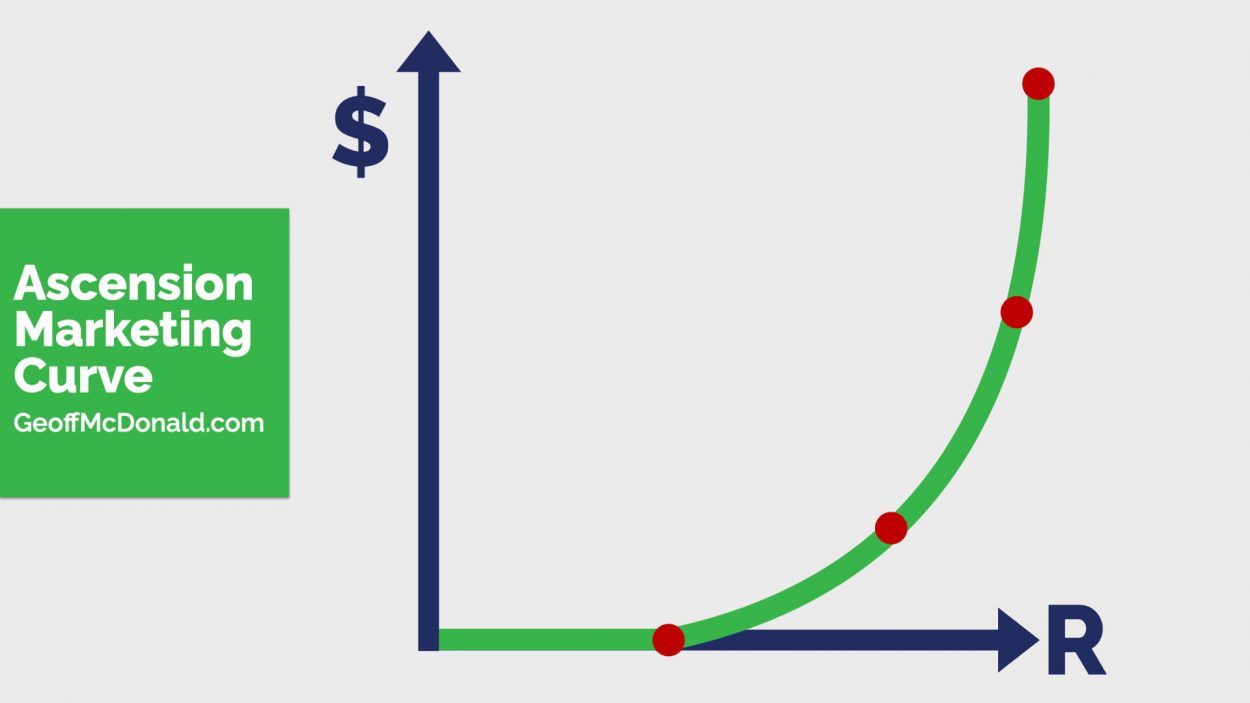
Best of all, I’m producing one set of content to attract new clients and keep my existing clients.
This mirrors the Ascension Marketing Curve we shared in an earlier post. Ideally, if you can create a smooth transition from your free content to your paid service you will make it easier for clients to buy from you.
Summary: The Best Thought Leadership Content Strategy
Let’s summarize what we’ve covered here.
- The best thought leadership content strategy uses Capital Content. It provides a single set of content to attract new clients and keep your existing clients.
To define your Capital Content, you need to answer these three questions:
- How do you provide value to your clients?
- Where have you bought something similar?
- How can you support your clients when you’re not there?
And the key principle for creating great content is: Treat everyone as a client
Next in the Content Creation Canvas Series
This is part five in the Content Creation Canvas Series. Once you’ve defined your Capital Content, then you can move on to our next post in this series where you’ll get specific about your content. You’ll define:
- What to create
- When to create it
- And where to share it
More on Thought Leadership Content Strategy
Here are three more resources to help you dive deeper into creating Thought Leadership content that attracts and keeps your clients.
- Overview: Content Creation Canvas: Build thought leadership, attract new clients
- Part 1 in this 7-part series: Content Strategy 2022 – Best framework for Thought Leaders
- More on Capital Content: A Daring Content Creation Idea to Double Your Results
The Big Question
Add a comment below when you have answered this big question:
What is your Capital Content – how will you attract and keep clients with one set of content?

